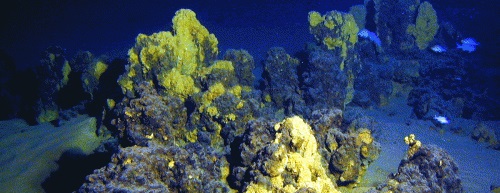Kermadecs Geology
The Kermedec region includes outstanding examples of major stages in the geological evolution of the Earth. In geological terms, its value includes an entire cross section of the collision of two tectonic regions (the Pacific Plate and the Australian Plate), a large portion of the deepest sea-floor region in the southern hemisphere, and a major chunk of the longest submarine volcanic arc on the planet[1].
The volcanic islands of Raoul, Macauley, Curtis and L’Esperance are the emergent summits of large, complex stratovolcanoes that form part of a volcanic arc and subduction system extending from temperate New Zealand to tropical Tonga as part of the Pacific Ring of Fire[2].
The seabed around the islands is extremely deep – 95% of it descends to over 1,000 m and 33% to over 5,000 m[3]. The Kermadec – Tonga Trench drops to over 10,000 m – deeper than the 8,848 m Mount Everest is high. It is the deepest ocean sea-floor region in the southern hemisphere.
AN ARC OF ACTIVE VOLCANOES
The Kermadec Islands and associated submarine volcanoes along the Kermadec Arc are superlative natural phenomena. They display significant ongoing geological processes in the development of arc-styled volcanism, submarine hydrothermal venting and geomorphic features. In addition, the arc’s seamounts include a variety of volcanic landforms such as cones and calderas.
In recent years, six deep-sea expeditions have been undertaken to describe and survey the area in detail. Since 2002, several sea-floor geological voyages have mapped all the larger volcanoes of the Kermadec Arc from White Island in the Bay of Plenty to the Kermadec Island group (including the submarine flanks of Macauley and Raoul islands), and northward to southern Tonga. More than 50 new submarine volcanoes have been discovered in the past decade.
Many of the Kermadec submarine volcanoes are comparable in size and form to the more visible terrestrial New Zealand volcanoes, such as Mount Taranaki and Mount Ruapehu. At least eight of the Kermadec seamounts are over 2,000 m in elevation. One rises to within 65 m of the sea surface, while the summits of others reach no higher than 1,500 m below the surface. The largest volcano is 25 km in diameter, and at least 16 are more than 10 km in diameter. Macauley Island is part of a large volcanic complex at least 35 km in diameter. The island itself represents less than 5% of the emergent portion of the volcano, and the rim is capped by more than 30 vent cones that have emitted recent lava flows both into the caldera and down the outer-rim flanks.
HYDROTHERMAL VENTS
Many of the volcanic centres along the Kermadec Arc are hydrothermally active[4]. The fluids flowing from hydrothermal vents at these seamounts are of scientific interest because of their unusual chemistry. New populations of organisms are still being discovered here, many of them uniquely adapted to the depth, geochemistry and flow characteristics of the venting fluids. Separated by distances of as little as 50 km, the unique flora and fauna present suggest there may be a high degree of evolutionary diversity along the Kermadec Arc.
New Zealand seamounts and above-water archipelagos, including those within the Kermadec region, are regarded as one of the areas of greatest ocean primary productivity in the southwest Pacific, and a centre of global ecosystem reproduction[5]. Active volcanic seamount vents discharge minerals, which are in turn dispersed by ocean currents. These minerals are thought to provide nutrients for the tiny organisms on which ocean food webs and fisheries are based.
Hydrothermal vents produce extreme conditions that appear inhospitable to living organisms, but in fact allow life to flourish. In these totally dark environments, living organisms are exposed to high pressure in waters containing elevated levels of toxic compounds such as hydrogen sulphide, and temperatures of up to 370°C. Despite the harsh environment, vents can be colonised by a flourishing fauna reliant on bacterial chemosynthesis and adapted to live in the extreme conditions. In fact, deep seabed areas, particularly hydrothermal vents, could be one of the origins of life on Earth. The role of hydrothermal plumes in supporting upper zooplankton communities also demonstrates the importance of these ecosystems in maintaining the global carbon cycle.
It is now widely recognised that deep seabed genetic resources able to thrive in extreme conditions hold great potential for various beneficial applications, including uses in the health sector, for industrial processes, and in the bioremediation of polluted industrial sites[6].
 Photo: NOAA/NIWA/GNS
Photo: NOAA/NIWA/GNSOld chimneys from Giggenbach seamount.
[1] DOC 2006
[2] Wright et al. 2006
[3] Francis et al. 2009
[4] de Ronde et al. 2007
[5] Terra Nature 2004
[6] Terra Nova 2004












